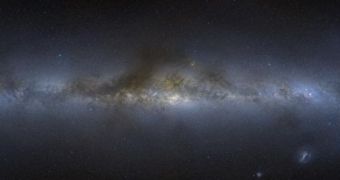Central Michigan University professor Axel Mellinger has recently compiled a new groundbreaking image of the night sky, with the Milky Way at its center, by stitching up more than 3,000 individual photographs. The high-resolution panoramic view, presented in an interactive manner here, can be used by professional and amateur astronomers alike, and shows known features of our galaxies in great detail. The creation process for the new image is described in the November issue of the respected journal Publications of the Astronomical Society of the Pacific.
“This panorama image shows stars 1,000 times fainter than the human eye can see, as well as hundreds of galaxies, star clusters and nebulae,” Mellinger reveals, adding that his panorama is fitted for both scientific and educational purposes. He says that the real work on the project started just after the thousands of pictures he needed were collected, from dark-sky locations in South Africa, Texas and Michigan. Mellinger traveled more than 26,000 miles in order to capture all the images he needed for a complete panorama.
“Due to artificial light pollution, natural air glow, as well as sunlight scattered by dust in our solar system, it is virtually impossible to take a wide-field astronomical photograph that has a perfectly uniform background,” he reveals. Snapping all the photos and stitching them together took a grand total of more than 22 months, the expert adds. Most of that time was spent in front of the computer, using a mathematical model that allowed for compensation in the distortions that appear in 2D images.
Each of the photos was a two-dimensional projection of the area it depicted, and, as such, featured a number of distortions that needed to be accounted for. The mathematical model Mellinger used had precisely this purpose. It helped him clear light pollution and other damaging factors from the image, and produce a panorama that is really a sight to behold. Data sets from the Pioneer 10 and 11 space probes were also incorporated in the new map, the professor admits.
The end result of all the work and trouble was a massive, 648-megapixel image, which the expert photographer hopes to make available in as many planetariums around the world as possible. Mellinger has more than 30 years of experience in astronomy and astrophotography, in spite of the fact that his daytime job is as an expert in the field of polymer physics.

 14 DAY TRIAL //
14 DAY TRIAL //